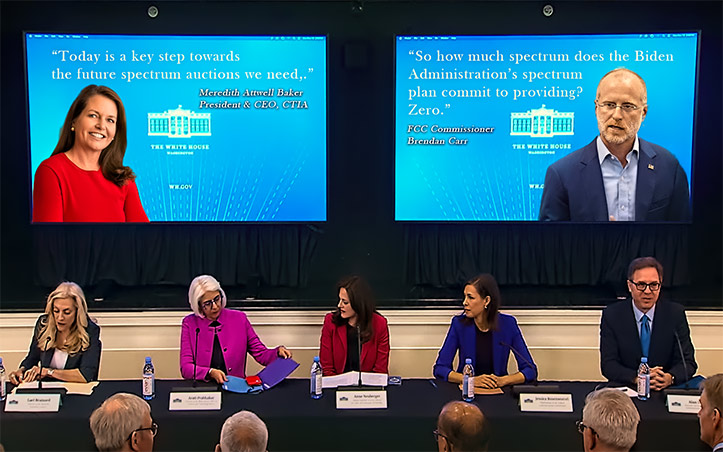
ROLLING OUT A LEAN STRATEGY – Critics of the strategy believe it’s nothing but a study that acknowledges the wide range of wireless technologies that exist today, and it lacks specifics. The administration’s strategy is to “help to address spectrum challenges facing the Nation, including charting a path to satisfy current and future spectrum access requirements,” with many of those efforts already underway. As expected, trade organizations offered statements of appreciation for the administration’s efforts. FCC Commissioner Brendan Carr, however, slammed the report stating, “So how much spectrum does the Biden Administration’s spectrum plan commit to providing? Zero.”
The Biden Administration released a National Spectrum Strategy identifying more than 2,700 megahertz of airwaves to study for innovative new uses by the private sector and federal agencies. President Biden also released the Presidential memorandum on Modernizing the United States Spectrum Policy and Establishing a National Spectrum Strategy, which will promote a trustworthy, predictable, and evidenced-based process for ensuring spectrum serves its highest and best use.
The industry mostly commended the plan, with CTIA President Meredith Baker stating, “In order to meet growing consumer demand for 5G, close America’s widening 5G spectrum deficit, and counter China’s global ambitions, America’s wireless networks need 1500 MHz of additional full power, licensed spectrum with the next ten years.”
“WIA commends the Biden Administration for putting forward a National Spectrum Strategy that provides clarity on a spectrum pipeline, includes assurances for transparent and inclusive processes, and recognizes the importance of a workforce to implement our spectrum goals,” said WIA President and CEO Patrick Halley.
Although the underlying subtext in multiple other organizations’ couched applause emphasized the high-level policy statement for more spectrum, FCC Commissioner Brendan Carr slammed the report, stating, “After nearly three years of study, the Biden Administration does not commit to freeing up even a single MHz of spectrum. Instead, they are announcing that they will continue studying the issue for years to come.”
“What we are seeing right now is a complete 180 from the progress we made under the prior Administration. From 2017 through 2020, the FCC freed up roughly 6,000 MHz of spectrum for licensed use alone plus thousands of additional MHz of spectrum for unlicensed use. The Biden Administration only plans to study less than 2,800 MHz. In other words, the Trump Administration put more spectrum into the commercial marketplace for consumer use than the Biden Administration plans to study—and it is not even close,” Carr said.
In March of 2021, Carr put out a spectrum plan that identified specific frequencies and a timeline for action.
In a Tweet, former FCC Commissioner Ajit Pai also criticized the strategy.
“Not one spectrum auction has originated after January 2021. The ‘new’ spectrum ‘strategy’ proposes nothing but … years of ‘study’. We need a calendar describing spectrum bands to be auctioned—and when. This is simple. There’s no good reason not to do it,” wrote Pai.
His statement carboned a Tweet that FCC Commissioner Jessica Rosenworcel said in April of 2021: “It’s time for transparency: The FCC needs to publish a calendar that lets our wireless economy plan for the future by describing just what spectrum bands will be auctioned and when. This is simple. There’s no good reason not to do it.”
However, in a statement released yesterday, Chairwoman Rosenworcel said, “Though it is not the subject of the National Spectrum Strategy, there is one other thing that is fundamental. In fact, it is necessary for this strategy to be a success—and that is restoration of the FCC’s spectrum auction authority. For three decades, the FCC has used this authority to distribute licenses for our airwaves so commercial actors can deploy, create, and innovate. Over this time, the FCC has held 100 auctions and raised more than $233 billion for the United States Treasury. As a result, our auction program has enjoyed strong bipartisan support here at home, and our efforts have been a model for regulators worldwide. For all these reasons, in the past Congress always extended FCC auction authority without interruption. That did not happen this time around and we need to fix it—stat. Because restoring this authority will provide the United States with the strongest foundation to compete in a global wireless economy, counter our adversaries’ technology ambitions, and safeguard our national security. It will also provide us with the tools essential to take the airwaves this strategy identifies to commercial markets for 5G, 6G, and beyond.”

















